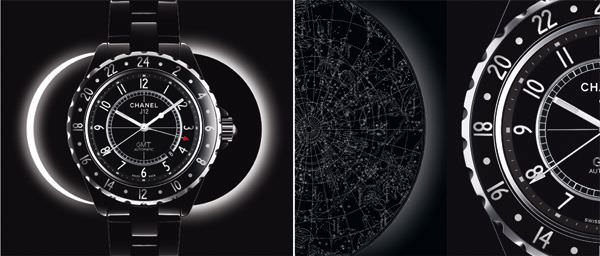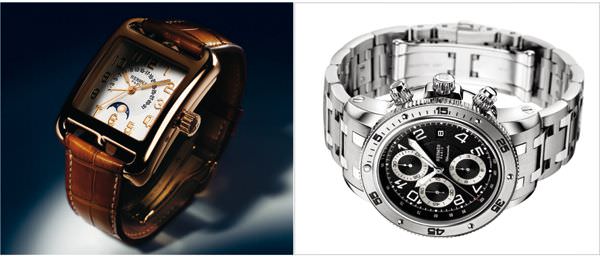Chanel, Hermès, and Louis Vuitton. What do these three brands have in common? None of them is originally from the domain of watchmaking. Chanel comes from the world of haute couture; Hermès has its origins in saddlery and leather goods; and Louis Vuitton started with luggage. All three, however, have succeeded in expanding their universe to include numerous other areas that were not part of their basic vocation, and they all have global distribution networks.
And, what else? Chanel, Hermès, and Louis Vuitton have all expertly entered the world of horology, and have even succeeded in becoming members of the very small club of legitimate watchmakers. Each has done so in its own way: Chanel, thanks primarily to a model, the J12, which has become a timekeeping icon, created by the late Jacques Helleu; Hermès, because of the very patient and very progressive construction of its own watch verticalization, thus letting the brand fully master its new ‘mÉtier’; and Louis Vuitton, which created a singular offer, on both the aesthetic level as well as in distribution.
These three brands are at a point of ‘fusion’ between two worlds—the world of watches and the world of ‘fashion’. They each demonstrate in their own way that the lines can move, that nothing is fixed, and that legitimacy can be acquired or earned.

J12
Chanel and the J12
The J12 is not the first watch created by Chanel, but it is certainly the one that allowed the Parisian brand to enter full force into the universe of timekeeping. This was due to the insight and talent of Jacques Helleu (who unfortunately passed away last September). Helleu was a house ‘product’, we might say, because he entered Chanel at the age of 18, “to take care of the problem of taste,” as Pierre Wertheimer, the head of the brand, explained to him at the time.
Jacques Helleu was involved in a bit of everything, taking care of packaging and communication, before finally becoming Artistic Director of the brand. Passionate about mechanical things and a collector of cars, he himself admitted that in the place of perfume bottles, he often dreamed of “designing a locomotive”.
“Perhaps, I made up for this with watches,” he explained later, “since in steam engines, there are joys of graphic expression that I also find in the most beautiful mechanical watches. The success is spontaneously aesthetic, undoubtedly because it results more from a functional sol-ution than from artistic intention. I have always looked, in the watch, for the culmination of the idea that one finds only in timeless objects.”
Aiming for this “timelessness”, Jacques Helleu wanted to create a strong and unique object “that could remain a reference”, beyond a simple collection.
He took seven years to construct and finalize the J12 as we know it today. His inspiration was, as he himself has said, “a cocktail of influences and references” that the watch succeeded in unifying and melding into a product with a strong identity, a product that was immediately recognizable. The origin of its name, said to be one of these major influences, comes from the code name, J12, of the J classes of the Americas Cup, which the famous Baron Bich used in training for the race. Another reference was the universe of the automobile, with its brilliant bonnets and profiled shapes. Another was the hi-tech world, with all its advanced materials. Yet, to all these external influences, we must add the codes of the house of Chanel, codes that ‘Mademoiselle’ Coco Chanel herself defined: purity of lines and an extreme penchant for black and white.
In the beginning, in 1994, explained Jacques Helleu, “the technical methods to create the J12, such as I had visualized it, did not exist. No one was capable of giving me the brilliant and stable black that I needed. This doesn’t even count the fact that no one saw any interest for Chanel in creating a watch, especially a masculine watch.”
The solution—and the stroke of genius—came with the use of ceramic, a material that is nearly as hard as a diamond. Of course, ceramic was already being employed in watchmaking, notably by Rado, but it was never utilized in this way, with such flexibility and fluidity (we recall, for example, the links articulated with rubber), or in combination with diamonds, rubies, or, more surprisingly, with aluminium in the Superleggera model.
When the J12 was launched, the ‘real’ watchmakers smiled politely. To them, it was only a ‘fashion’ phenomenon. Little by little, however, they had to face the fact that the J12 was becoming an ‘icon’ that would become part of watchmaking history. Chanel would later boldly push the limits even further by presenting a tourbillon mounted on a ceramic bridge—a first that signalled the entrance of the brand into the circle of legitimate watchmakers. In the meantime, Chanel established its own watchmaking ateliers in La Chaux-de-Fonds, right at the core of the ‘sacred’ perimeter.

CAPE COD and CLIPPER CHRONOGRAPH
Hermès, watchmaking step by step
HermÈs distinguishes itself from many other fashion and accessory houses by its painstaking requirements for mastery over what it calls its different ‘mÉtiers’, beginning with that of leather goods. A ‘mÉtier’ by definition, this vocation is not one of improvisation but has been acquired by diligent effort over the years. Hermès has applied this true professional code of ethics, to the letter, to its own foray into watchmaking. With infinite patience, working in a progressive and measured manner, step by step, the brand has devoted itself to acquiring the various types of expertise that constitute the vocation of timekeeping.
Yet, Hermès’ involvement in watchmaking is not recent. Already in 1912, the brand crafted a leather strap for a pocket watch. Then, with the growing popularity of the wristwatch starting in the early 1920s, Hermès made and sold watch straps. In 1928, it began selling its own watches, notably the famous Ermeto, a pocket watch that was wound with a slide mech-anism. From then on, the French brand continued to make watches, es-pecially in collaboration with Jaeger, Universal, and Vacheron & Constantin. In passing, we mention the belt watches for golfers in 1928 and the ‘Etrier’ pieces of the 1950s and 1960s. With the arrival of quartz, HermÈs launched the famous Kelly, inspired by the little padlocks on its handbags of the same name. The brand’s watch production then took off—the Clipper arrived in 1981, the Sellier in 1987, the Cape Cod in 1991 (with its double-tour strap in 1998), the MÉdor in 1993, and the H-our in 1997.
Starting in 1978, Hermès created a watchmaking subsidiary, Montre HermÈs SA, situated in Bienne. Gradually, this entity would develop and expand. In 2003, Hermès began to collaborate with Manufacture Vaucher, which equipped the Dressage watch with its first automatic movement. In 2004, Manufacture Vaucher specially developed a retrograde date and lunar phase movement for the Dressage. In ‘return’, Hermès delivered leather straps to Parmigiani.
In October 2006, an additional step was taken. Hermès International invested CHF 25 million to purchase a 25 percent share of Vaucher Manufacture Fleurier. This stake in Vaucher was decided “in order to create an environment destined specifically for the fabrication of Hermès movements,” explains Emmanuel Raffner, who is, today, at the helm of Montre Hermès SA. “We wanted to create an industrial tool in the service of the development of Hermès watches,” he continues, “in order to supply, little by little, highly technical movements with a maximum level of finishing to our collections. But our ambition is two-fold—while we want to put great movements in our HermÈs watches, we also want to put Hermès into the movements.”
This last assertion, “put HermÈs into the movements,” says a lot about the ambition of the brand, which, after 30 years, has become an authentic watchmaker. “Each year, we are going to present an additional compli-cation in the Dressage collection, and gradually rise in strength as this new approach is assimilated by our entire network,” adds Raffner. “Our reason-ing must be perfectly understood by our clients. We must change existing mentalities and explain why the prices of our models are higher. But at the same time, we absolutely want to maintain our identity: our products are reliable; they are made to be worn; they are made to age well; they are the expression of a very high level of savoir faire.”

TAMBOUR COLLECTION
Louis Vuitton and its Tambour
Louis Vuitton, the largest luxury brand in the world, took its time before deciding to move into watches, for which its vocation of a luggage manufacturer—and specialist in travel and hence time zones—provided a good connection. In fact, it was only in 2002 that the brand launched its Tambour, whose form and name are taken from the German timekeepers created around 1530 and 1540. This timepiece was immediately recognizable for its bulbous design, its chocolate or sable dials that evoked the codes of the brand, its discreet Monogram, and its yellow seconds hand inspired by the linen thread coated with beeswax that is used in leather goods. These were among the many elements that distinguished this creation from other brands.
In 2004, concerned about assuring the development of its watchmaking arm, Louis Vuitton created a watch atelier in La Chaux-de-Fonds. The logic behind this move, as the management of Louis Vuitton repeats over and over again, is “the total control over the production and distribution of our watches.”
On the production side, the atelier in La Chaux-de-Fonds, which employs some 60 people, is devoted to: the technical validation of the designs coming from the mother company; the determination of their industrial feasibility; the relationships with the network of subcontractors in the Jura region which the brand primarily uses; quality control and the assembly of the pieces.
On the distribution side, Louis Vuitton has opted for a policy of exclusivity, thus assuring ‘exceptional service’. In fact, Louis Vuitton watches are distributed exclusively through a restricted number—about 150—of the Louis Vuitton stores around the world. In this way, the brand is innovative in comparison to traditional watch brands, whose distribution in their own boutiques is an added bonus—often in terms of image.
This extremely selective distribution is contributing to making Louis Vuitton watch products particularly elite. The success of Tambour, through its many models, has largely proven the strength of its design. It is a design that is capable of accepting movements and functions that are becoming increasingly more complex—GMT automatic alarms, divers’ watches, regatta chronographs, and even lovely Monogram tourbillons—as well as decor-ations that are becoming increasingly more jewellery oriented, such as the Tambour Fleurs PrÉcieuses Nacre and the Tambour Forever, for example.
To this first collection, which is continuing to expand, has come another form collection, the Speedy, which attests to the brand’s growing watchmaking maturity.
Source: Europa Star December-Januar 2008 Magazine Issue





